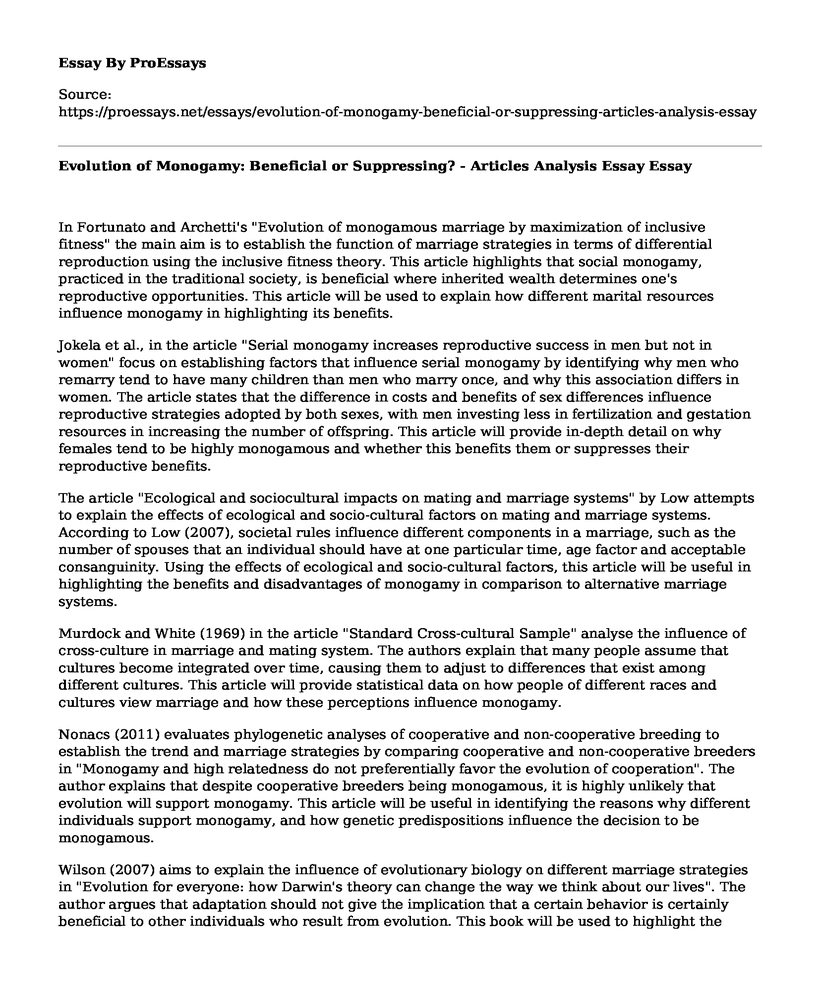In Fortunato and Archetti's "Evolution of monogamous marriage by maximization of inclusive fitness" the main aim is to establish the function of marriage strategies in terms of differential reproduction using the inclusive fitness theory. This article highlights that social monogamy, practiced in the traditional society, is beneficial where inherited wealth determines one's reproductive opportunities. This article will be used to explain how different marital resources influence monogamy in highlighting its benefits.
Jokela et al., in the article "Serial monogamy increases reproductive success in men but not in women" focus on establishing factors that influence serial monogamy by identifying why men who remarry tend to have many children than men who marry once, and why this association differs in women. The article states that the difference in costs and benefits of sex differences influence reproductive strategies adopted by both sexes, with men investing less in fertilization and gestation resources in increasing the number of offspring. This article will provide in-depth detail on why females tend to be highly monogamous and whether this benefits them or suppresses their reproductive benefits.
The article "Ecological and sociocultural impacts on mating and marriage systems" by Low attempts to explain the effects of ecological and socio-cultural factors on mating and marriage systems. According to Low (2007), societal rules influence different components in a marriage, such as the number of spouses that an individual should have at one particular time, age factor and acceptable consanguinity. Using the effects of ecological and socio-cultural factors, this article will be useful in highlighting the benefits and disadvantages of monogamy in comparison to alternative marriage systems.
Murdock and White (1969) in the article "Standard Cross-cultural Sample" analyse the influence of cross-culture in marriage and mating system. The authors explain that many people assume that cultures become integrated over time, causing them to adjust to differences that exist among different cultures. This article will provide statistical data on how people of different races and cultures view marriage and how these perceptions influence monogamy.
Nonacs (2011) evaluates phylogenetic analyses of cooperative and non-cooperative breeding to establish the trend and marriage strategies by comparing cooperative and non-cooperative breeders in "Monogamy and high relatedness do not preferentially favor the evolution of cooperation". The author explains that despite cooperative breeders being monogamous, it is highly unlikely that evolution will support monogamy. This article will be useful in identifying the reasons why different individuals support monogamy, and how genetic predispositions influence the decision to be monogamous.
Wilson (2007) aims to explain the influence of evolutionary biology on different marriage strategies in "Evolution for everyone: how Darwin's theory can change the way we think about our lives". The author argues that adaptation should not give the implication that a certain behavior is certainly beneficial to other individuals who result from evolution. This book will be used to highlight the history and disadvantages of monogamy before drawing a conclusion on the argument.
References
Fortunato, L. and Archetti, M. (2010). Evolution of monogamous marriage by maximization of inclusive fitness. Journal of Evolutionary Biology, vol. 23, Iss. 1, pp.149-156. doi:10.1111/j.1420-9101.2009.01884.xJokela, M., Rotkirch, A., Rickard, I. J., Pettay, J., & Lummaa, V. (2010). Serial monogamy increases reproductive success in men but not in women. Behavioral Ecology, vol. 21, iss. 5, pp. 906-912. doi:10.1093/beheco/arq078
Low, B. S. (2007). Ecological and sociocultural impacts on mating and marriage systems. In: Oxford Handbook of Evolutionary Psychology (R.I.M. Dunbar & L. Barrett, eds), pp. 449-462. Oxford: Oxford University Press.
Murdock, G.P. and White, D.R. 1969. Standard crosscultural sample. Ethnology, vol. 8, pp.329-369.
Nonacs, P. (2011). Monogamy and high relatedness do not preferentially favor the evolution of cooperation. BMC Evolutionary Biology, vol. 11, Iss. 1, pp. 58-64. doi:10.1186/1471-2148-11-58
Wilson, D. S. (2007). Evolution for everyone: how Darwin's theory can change the way we think about our lives. New York: Delacorte
Cite this page
Evolution of Monogamy: Beneficial or Suppressing? - Articles Analysis Essay. (2022, Jun 04). Retrieved from https://proessays.net/essays/evolution-of-monogamy-beneficial-or-suppressing-articles-analysis-essay
If you are the original author of this essay and no longer wish to have it published on the ProEssays website, please click below to request its removal:
- Race and Its Representation Through Media
- Negative Impacts of Social Media in the Society Essay
- University Tries to Mend Racial Divisions Paper Example
- Research Paper on Racial Discrimination in the Criminal Justice System
- Physiological Barriers in Communication Essay Example
- Essay Example on Free Black Activism: Demanding Rights, Justice, and Liberty
- Essay Example on Teen Magazines: Keeping Teens in the Know!







